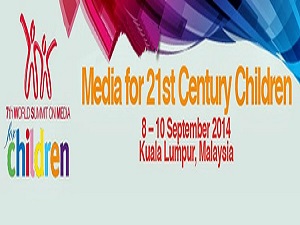The 7th World Summit on Media for Children (WSMC) held at Royale Chulan Hotel, Kuala Lumpur, Malaysia on September 8-10, 2014 was participated by over a thousand media producers, educators, media legislators from 61 countries. Among them were Sr. Consolata Manding, Sr. Lorena Briones (Philippines), Sr. Bibianah Densia (Sabah, Malaysia), Sr. Shirley Chong, Sr. Rosalie Lojiu, Sr. Mary Sualeh and Sr. Elizabeth Jothee (Selangor, Malaysia) attended.


Held for the first time in Asia, the summit’s theme was Media for 21st Century Children. Organised by the Asia-Pacific Broadcasting Union (ABU) and the World Summit on Media for Children Foundation and hosted by Radio Television Malaysia (RTM), it aims to achieve a greater understanding of developments in children’s media around the world and to raise the status of children’s programming. It also draws to the attention of key people in production and distribution the importance of issues relating to children and young people.
World experts on children and media led a day of interaction and planning during seven parallel pre-workshops on September 8. Workshops topics ranging from how to produce strong stories for children and how to write winning program proposals, to children’s media being at the core of public service media, social media trends and feature animation films, attracted hundreds of participants and hours of lively discussion. A symposium on media and children’s rights in the digital age saw high level of participation across the spectrum of broadcasters, regulators, academia and the international community. The first day ended with a free Romanian national radio orchestra concert held at Petronas Tower.

The opening ceremony last September 9 was streamed live across the world by Radio Television Malaysia. The keynote speech was given by Honorable Datin Paduka Seri Rosmah Mansur, the wife of the Prime Minister of Malaysia.
There were six (6) sessions with 20 speakers on the second day and seven (7) sessions with 21 panellists or speakers on the last day. The speakers were from the different countries.
Rhaydz B. Barcia, photo journalist in Bicol region writing for Manila Times and a stringer of Thomson Reuters and the Philippine News Agency was one of the panellists. She represented the Philippines and she shared about her experiences and work in the field of journalism.
The following were the topics of the summit conference for two days:
September 9 – Potential for Media to Transform Children’s Education, Kids 3.0: Living in a Digital World, Digital Age Storytelling: The Everlasting Power of a Good Story, Programming for Children across all Platforms, Bridging the Global Media Divide for Children, Showcase: Social Media use by Children and Adolescents: Challenges and opportunities for all stakeholders.
September 10 – Raising the Profile of Children’s Media, Creativity and Innovation in Education, Media Law, Policy and Children’s Privacy, Media Violence, Stereotyping and Advertising – Comparative Perspectives of Adults and Kids, Best Practices in Interactive Media – Television, Gaming, Mobile and Online, Funding Children’s Content: Challenges and Opportunities, Media, Social Responsibility and Children.
Before the closing session, the organizer encouraged the delegates to share their ideas and perspectives by posting in the Conference Declaration. After the closing ceremony, the delegates were invited to watch the “Tip Tap Top the Time Tunnel”, a performance by Malaysian artists at Auditorium Perdana, Angkasapuri.


In one of the conferences, Sr. Consolata posed a question on ethics in media. After the summit, Sr. Elizabeth and Sr. Lorena were briefly interviewed by a member of SIGNIS Malaysia.
WSMC 2014 pledges to reframe children’s media and take it to a New Paradigm considering:
– that it is imperative to raise the status of children’s programming in the overall media industry; that it is most important to create ample opportunities for development of quality children’s programming all over the globe taking advantage of the “digital wave”;
– that it is essential to draw to the attention of the key players in media industry the importance of issues relating to children and youth;
– that all sections of the media industry need to recognize their responsibility to provide quality media content to improve the lives of the children and the youth and contribute to enrichment of the civil society;
– that the Internet has provided connectivity to the children, opening up direct access to the media, social media networks and transforming them into citizen journalists;
– that a primary concern is the gap between children who have access to content and those who do not; that new media has many negative aspects as well, in particular easy access to inappropriate content, making it essential for media practitioners follow ethical norms in this regard.
– Noting that media has the responsibility to develop content in a responsible manner; that there is a crying need to help the children to choose between good and undesirable content;
– that to achieve the objectives cited in the considering above, it would be essential for the media industry to agree on a charter of guiding principles in children’s media; that to meet some of the requirements, it will be essential to establish a dynamic international movement for improvement of content of children’s programming in radio, TV, new media and the print media;
– that funding of quality content and the growing number of children not having access to media are among the main challenges for the children’s media industry.

Dr. Patricia Edgar, Founder and Chair of World Summit on Media for Children said, “The future requires us to think and act differently – to be bold, imaginative, and creative on behalf of children.”
By: Sr. Lorena Briones, FSP

